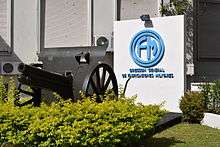Fabricaciones Militares
 | |
 | |
| State-owned | |
| Industry |
Arms industry Rolling stock Mining Chemicals |
| Founded | 1941 |
| Founder | Government of Argentina |
| Headquarters | Buenos Aires, Argentina |
Area served | worldwide |
| Products | UAVs, freight wagons, small arms, fertiliser, artillery, SAMs |
| Owner | Government of Argentina |
| Website | www.fab-militares.gob.ar |
Fabricaciones Militares (Dirección General de Fabricaciones Militares (DGFM)) is a state-owned Argentine arms manufacturer based in Buenos Aires. Founded in 1941, over the years the company has diversified into different areas such as mining, petroleum, rolling stock and petrochemicals. The company is under the direction of the Argentine Ministry of Defence.
History
The company was created in 1941, under Argentine law 12.709,[1][2] in order to expand the Argentine defense industry to compensate for the shortfall of imports that came about during the Second World War. In its early years, it produced primarily small arms and munitions whilst aiding in the development of other key industries in the country. The company expanded quickly and would eventually have 14 factories around the country.[3] However, starting in the 1980s, many of these plants were sold to private firms.[4][5][6]
The company has a long history of producing rolling stock for the Argentine railways. It has produced trams, urban commuter rail trains and trains for the Buenos Aires Underground.[7]
In more recent years, the company has begun to grow again, acquiring new factories and expanding into more areas outside the arms industry.[8] This includes the production of rolling stock for the state-owned rail operator Ferrocarriles Argentinos's freight division Trenes Argentinos Cargas y Logística, which recently ordered over 1,500 carriages.[7]
In June 2015, the first 10 hopper cars manufactured by FM to transport cereal, were officially introduced as part of a contract to build 1050 cars for state-owned freight lines.[9] The wagons were produced in FM's factory in Río Tercero, Córdoba and each one has a capacity for 45 tons of grains. It is expected that the factory will manufacture 3 wagons per day, to be used in the three lines operated by the National Government, the San Martín, Belgrano and Urquiza.[10]
Other types of freight wagons to be produced by FM are flat, spine and tank cars.[10]
Gallery
 Argentine soldier with DGFM flamethrower (c.1940s)
Argentine soldier with DGFM flamethrower (c.1940s).jpg) Ñandú jeep (c.1940s)
Ñandú jeep (c.1940s) A 1960s tram
A 1960s tram- 127mm missile
 Rolling stock production at a DGFM factory
Rolling stock production at a DGFM factory
See also
| Wikimedia Commons has media related to DGFM. |
- Río Tercero explosion
- Scandal over Argentine arms sales to Ecuador and Croatia
- Fabrica Militar de Aviones
- Armed Forces of the Argentine Republic
- Trams in Buenos Aires
- TENSA
References
- ↑ Mariela Ceva (2000). Historia social argentina en documentos. Editorial Biblos. pp. 198–. ISBN 978-950-786-245-8.
- ↑ Claudio Belini; Marcelo Rougier (1 January 2008). El Estado empresario en la industria argentina: conformación y crisis. Ediciones Manantial. pp. 336–. ISBN 978-987-500-122-0.
- ↑ Industria argentina: revista de opinión e información tecnológica. Industria Argentina. 1978.
- ↑ Varios Autores (3 October 2012). Argentina. La búsqueda de la democracia. Tomo 5 (1960-2000). Penguin Random House Grupo Editorial España. pp. 144–. ISBN 978-84-306-0161-5.
- ↑ Siderurgia latinoamericana. ILAFA. 1995.
- ↑ Claudio Belini; Marcelo Rougier (1 January 2008). El Estado empresario en la industria argentina: conformación y crisis. Ediciones Manantial. pp. 77–. ISBN 978-987-500-122-0.
- 1 2 Fabricaciones Militares construirá más de 1000 vagones para el Belgrano Cargas - Fabricaciones Militares
- ↑ Fabricaciones Militares Argentinas inaugura una nueva planta de producción de explosivos Defensa - 23 July 2014.
- ↑ Cristina presentó los primeros vagones construidos en Fabricaciones Militares - Telam, 1 July 2015.
- 1 2 "Presentaron vagones de carga fabricados en Río Tercero", Cadena 3, 1 Jul 2015
Further reading
- Dirección General de Fabricaciones Militares: un pilar industrial del país. Torino, Manuel Cornejo. Ediciones Universidad Católica de Salta, Salta, Argentina, 2003. ISBN 950-623-010-2 (Spanish)